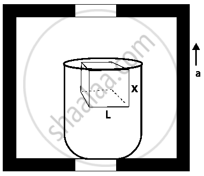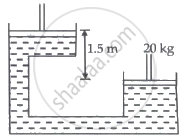Advertisements
Advertisements
प्रश्न
A cubical block of density ρ is floating on the surface of water. Out of its height L, fraction x is submerged in water. The vessel is in an elevator accelerating upward with acceleration a . What is the fraction immersed?
उत्तर
When a fluid is subjected to constant vertical acceleration, its free surface remains horizontal as the net effective gravity is acting vertically. But the magnitude of pressure at a point in the fluid increases or decreases depending upon the direction of acceleration.

Through the principle of floating when the block gets submerged in water
`Vpg = V^'Pwg`
Where V' = Volume of water displaced by block
V' = Base area of block × Height of block inside the water
`V^' = L^2x`
Let V be the volume of the block and Pb by the density of the block
Hence, `V = L^2 xx Pw`
`(Pb)/(Pw) = x/L` ......(1)
`x = (Pb)/(Pw) L`
As the block lifts upward, the acceleration = (g + a)
Weight of L3 Pb block = `m(g + a) = V c Pb(g + a) = L^3 Pb(g + a)`
Let x1 be the part of block which is submerged.
We know that the buoyant force will be equal and opposite to the weight of the block.
`L^2 Pb(g + a) = x1L^2 Pw(g + a)`
So, `(Pb)/(Pw) = (x1)/L`
So, `x1 = (Pb)/(Pw) L` ......(2)
From (1) and (2) we can infer that `(Pb)/(Pw) L` is the part of the block which is submerged in water. This is independent of the acceleration of the block (upwards, downwards or at rest).
APPEARS IN
संबंधित प्रश्न
A hydraulic automobile lift is designed to lift cars with a maximum mass of 3000 kg. The area of cross-section of the piston carrying the load is 425 cm2. What maximum pressure would the smaller piston have to bear?
In a hydraulic press, there is a larger piston of diameter 35 cm at a height of 1.5 m relative to the smaller piston of diameter 10 cm. A 20 kg mass is loaded on the smaller piston. The density of oil in the press is 750 kg/m3. The thrust on the load by the larger piston is ______.

